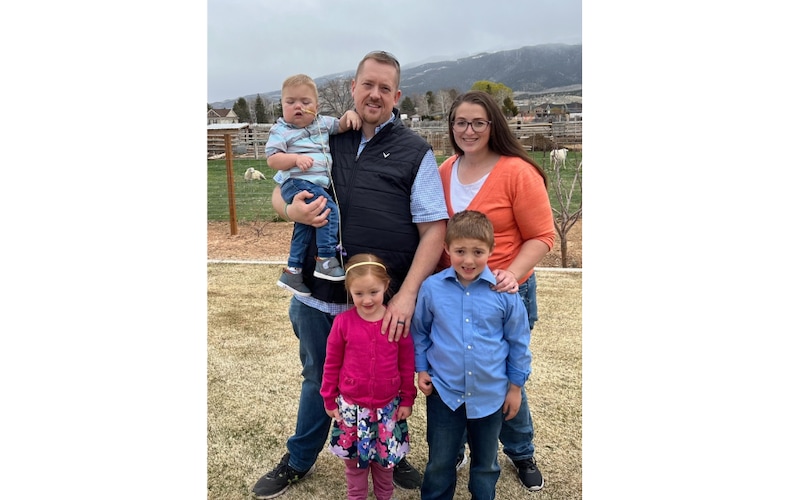This story is part of The Salt Lake Tribune’s ongoing commitment to identify solutions to Utah’s biggest challenges through the work of the Innovation Lab.
[Subscribe to our newsletter here.]
For Kasey Shakespear and his family, getting health care means driving for long hours.
His son, Isaac, now a 2-year-old, was born without kidneys — a rare condition known as bilateral renal agenesis. Isaac spent the first 6½ months of life in intensive care at Lucile Packard Children’s Health at Stanford in Palo Alto, California — almost a 12-hour drive from Shakespear’s St. George home.
“We were in a tough spot because we couldn’t actually afford to live in Pasadena or Palo Alto long term,” Shakespear said. Southern Utah’s booming housing market, at the same time, meant that if they sold their home, they wouldn’t be able to buy again for at least a year.

(via Kasey Shakespear) The Shakespear family has had to travel long distances to receive the speciality care needed for their youngest child, Isaac, who was born with a rare health condition.
The situation led to Shakespear commuting long distances while his son got lifesaving treatments, along with coping with chronic separation and stress. “It was a challenge,” he said in an interview. “My wife did not step foot in our house for nine months.”
With the family now back in St. George, Shakespear’s regular expeditions to and from California have given way to monthly four-hour drives each way to Primary Children’s Hospital in Salt Lake City for specialized care.
A new survey highlights the plight of Utahns dealing with severe illness while living in places with limited medical access.
Findings from researchers at the Huntsman Cancer Institute shed light on challenges faced by rural residents and frontier populations in five Mountain West states in getting vital care and even basic medical screenings.
Experts say the survey results are a road map for the Salt Lake City-based cancer center and other health care providers trying to make distance a less dire disparity for their patients.
The goal? “We want to be able to bring more care to people,” said Sachin Apte, physician-in-chief and chief clinical officer at the Huntsman Cancer Institute.
Hard numbers
About 48% of rural residents in the five states studied by Huntsman researchers have seen a physician in the past year — a steep difference from the U.S. average of 85%.
Only about a third of rural respondents, according to the Huntsman Cancer Institute survey, said they felt that they had easy access to medical specialists.
Rural residents were also far less likely to have had critical cancer screenings across the five-state area studied, including for breast, colorectal, lung and cervical cancers.
(Jud Burkett | Special to the Tribune) The sun sets over Intermountain Healthcare's St. George Regional Hospital Wednesday, Oct. 6, 2021.
Nationally, 22% of women of the recommended age in the U.S. have never had a mammogram. But the survey of rural residents found that 40% of women never had the test.
“People in our frontier communities just don’t have the frequency of interacting with health care as much,” said Tracy Onega, senior director of population sciences at Huntsman Cancer Institute and researcher at the University of Utah.
Nearly 88% of respondents said that they knew little or nothing about enrolling in clinical trials, which Onega said is now “the standard of care.”
Improving care
Easing these barriers is a challenge on multiple fronts.
About a third of respondents said more telemedicine would help, although 81% of rural residents have access to high-speed internet, compared to 91% of Americans nationwide. About 10% of those living in rural areas said they did not have cellphone coverage.
“So even if they were to try to access services through their phone instead of broadband,” Onega said, “that would also still be a challenge.”
(Francisco Kjolseth | The Salt Lake Tribune) The Huntsman Cancer Institute mobile cancer-screening bus during a stop Salt Lake City on Tuesday, Oct. 17, 2023. The bus is dispatched to underserved communities around Utah.
More than 69% of respondents said they would benefit from more visiting specialists, while others said expanding access to transportation, health education and walk-in clinics would also be benefits.
Huntsman Cancer Institute regularly sends cancer screening buses around the state, and its specialists travel to partner clinics in more rural areas.
Shakespear, who is also the assistant director of community programs for the Utah Center for Rural Health, said focusing on prevention is key. In places like Garfield County’s Tropic, where he grew up, the tendency is to put chores and other responsibilities ahead of a trip to a doctor.
Working to change that culture to “nip it in the bud before it gets bad,” Shakespear said, means finding ways to reduce travel times, especially for cancer care.
More with less
Katie Kerrigan, a medical oncologist at Huntsman, sees patients from Cedar City, consults with physicians in Blanding and recently had a patient make the long trip from Monument Valley for treatment.
“They don’t have the ability to do a lot of the things that we need to do with critically ill patients,” Kerrigan said, “and the travel is just brutal for these patients to come up.”
In the case of the Monument Valley patient, Kerrigan was so worried about the ability to make a 12-hour round trip drive to Salt Lake City twice a week, she frantically worked her phone to find closer alternatives.
(Rick Egan | The Salt Lake Tribune) View of Monument Valley, on Thursday, May 26, 2022.
Ultimately, Kerrigan said, the patient committed to making the grueling drive.
In Kanab, Kurt Loveless, CEO of Kane County Hospital, knows a lot of what rural patients are up against.
“We primarily have family practice doctors and they can stabilize patients,” Loveless said. But if someone has a stroke or cardiac, neurological or psychological issues, the patient is usually transferred 83 miles away to St. George Regional Hospital.
The hospital has no OB-GYN and one family practice doctor who specializes in delivering babies. High-risk pregnancies have to be handled in St. George. “That just simply means that when it comes time for delivery,” Loveless said, “they have to be very proactive.”
What happens when the doctor is on vacation?
“It requires him to schedule his life around moms and babies,” Loveless said. “Either that or he has to make arrangements for the mother to go to St George.”
A small community like Kanab doesn’t have the population to support a wide range of medical specialists.
Loveless said he is trying to partner with an oncologist in St. George so that patients might receive care through telemedicine but avoid long drives for treatments like chemotherapy. He’s also working on a similar arrangement for dialysis patients.
“People could tend to delay their health care,” Loveless said, “because they don’t want to make that long drive.”








